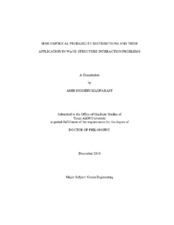| dc.description.abstract | In this study, the semi-empirical approach is introduced to accurately estimate
the probability distribution of complex non-linear random variables in the field of wavestructure
interaction. The structural form of the semi-empirical distribution is developed
based on a mathematical representation of the process and the model parameters are
estimated directly from utilization of the sample data. Here, three probability
distributions are developed based on the quadratic transformation of the linear random
variable. Assuming that the linear process follows a standard Gaussian distribution, the
three-parameter Gaussian-Stokes model is derived for the second-order variables.
Similarly, the three-parameter Rayleigh-Stokes model and the four-parameter Weibull-
Stokes model are derived for the crests, troughs, and heights of non-linear process
assuming that the linear variable has a Rayleigh distribution or a Weibull distribution.
The model parameters are empirically estimated with the application of the conventional
method of moments and the newer method of L-moments. Furthermore, the application
of semi-empirical models in extreme analysis and estimation of extreme statistics is discussed. As a main part of this research study, the sensitivity of the model statistics to
the variability of the model parameters as well as the variability in the samples is
evaluated. In addition, the sample size effects on the performance of parameter
estimation methods are studied.
Utilizing illustrative examples, the application of semi-empirical probability
distributions in the estimation of probability distribution of non-linear random variables
is studied. The examples focused on the probability distribution of: wave elevations and
wave crests of ocean waves and waves in the area close to an offshore structure, wave
run-up over the vertical columns of an offshore structure, and ocean wave power
resources. In each example, the performance of the semi-empirical model is compared
with appropriate theoretical and empirical distribution models. It is observed that the
semi-empirical models are successful in capturing the probability distribution of
complex non-linear variables. The semi-empirical models are more flexible than the
theoretical models in capturing the probability distribution of data and the models are
generally more robust than the commonly used empirical models. | en |


